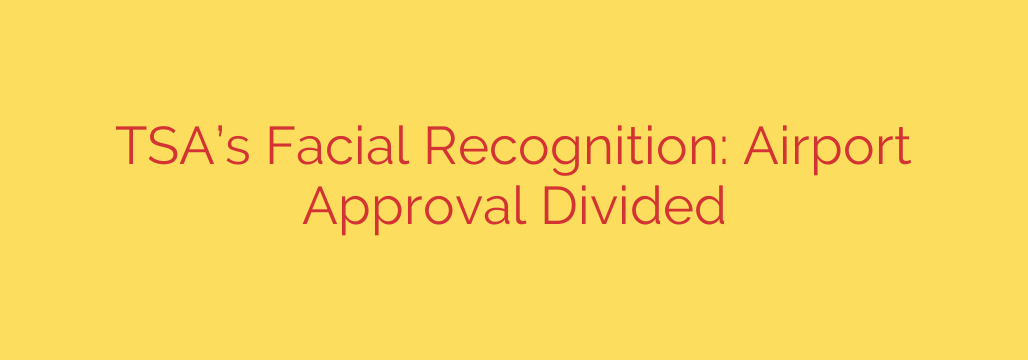
TSA Facial Recognition in Airports: The Future of Security or a Threat to Privacy?
The familiar shuffle towards the Transportation Security Administration (TSA) checkpoint is a routine part of modern air travel. But a new technology is rapidly changing this experience: facial recognition. Across a growing number of U.S. airports, travelers are now encountering cameras designed to verify their identity with a quick scan of their face.
Proponents hail it as a leap forward in efficiency and security, while critics raise serious alarms about privacy and surveillance. So, what does this technology mean for your next trip to the airport? Let’s break down how it works, the potential benefits, and the significant concerns surrounding its implementation.
How Does Airport Facial Recognition Work?
The process, known as biometric screening, is designed to be straightforward. When you approach the TSA podium, you’ll be asked to insert your driver’s license or passport into a card reader and briefly look at a camera.
In seconds, the system captures a live photo of you and compares it to the image stored on your government-issued ID. An algorithm analyzes your unique facial features to confirm a match. If the system verifies your identity, you proceed to the security screening. If it fails, or if you opt out, a TSA officer will manually check your documents, just as they have for years.
The Case for Facial Recognition: Efficiency and Security
The primary argument in favor of this technology centers on improving two key areas of the airport experience.
Streamlined Security Checks: For many travelers, the automated process can be faster than a manual ID check. This could lead to shorter lines and a more seamless journey through the airport, especially during peak travel times. The goal is to move people through checkpoints more quickly and reduce congestion.
Enhanced Security Measures: The TSA states that this technology is more effective than the human eye at detecting fraudulent documents and identifying travelers who may be using someone else’s ID. By automating the identity verification process, the system offers a higher degree of accuracy, freeing up TSA officers to focus on other critical security tasks, such as screening baggage for threats.
The Other Side of the Coin: Privacy and Security Concerns
Despite the potential benefits, the expansion of facial recognition is met with strong opposition from privacy advocates and civil liberties organizations. The concerns are significant and worth considering.
Data Privacy and Storage: A central question is what happens to your biometric data. While the TSA claims that photos of U.S. citizens are not stored after the identity match, critics are wary of how this data is handled, who has access to it, and how it’s protected. The creation of any system that processes and transmits facial data creates a potential target for data breaches.
Potential for Bias and Error: Facial recognition algorithms have historically shown biases, with higher error rates for women, people of color, and transgender individuals. An inaccurate rejection by the system could lead to unnecessary delays, invasive secondary screenings, and undue stress for innocent travelers.
The Risk of “Surveillance Creep”: Perhaps the most significant concern is that this technology paves the way for wider government surveillance. Critics worry that collecting biometric data at airports is the first step toward creating a massive, interconnected database that could be used to track individuals in public spaces, eroding personal anonymity and freedom. The fear is that a system built for convenience could evolve into a tool for constant monitoring.
Your Rights as a Traveler: Can You Opt Out?
This is the most critical piece of information for anyone concerned about this technology. As of now, yes, you can opt out of the facial recognition screening.
When you approach the checkpoint, you can inform the TSA officer that you do not consent to the facial scan. The officer will then proceed with a manual identity check, which involves physically examining your ID and comparing it to your face. While the TSA notes this manual process might take slightly longer, it is your right to request it. No traveler should feel pressured into submitting to a biometric scan if they are not comfortable doing so.
The Future of Airport Biometrics
The TSA is moving forward with its plan to expand the facial recognition program, with the goal of deploying it to over 400 federally run airports in the coming years. While the program remains voluntary for now, there have been discussions about eventually making it mandatory, a move that has been met with significant pushback from lawmakers and privacy groups.
Ultimately, the debate over facial recognition at airports is a classic conflict between security and liberty. While the promise of faster lines and tighter security is appealing, it comes with profound questions about privacy, data protection, and the kind of society we want to live in. As this technology becomes more common, it’s more important than ever for travelers to be informed about how it works and what their rights are.
Source: https://go.theregister.com/feed/www.theregister.com/2025/07/31/tsa_facial_recognition/








